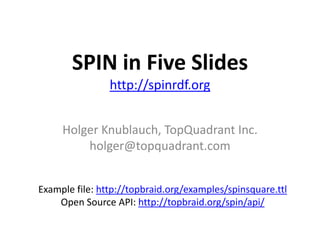Report
Share

Recommended
Recommended
More Related Content
What's hot
What's hot (20)
Open Source SQL - beyond parsers: ZetaSQL and Apache Calcite

Open Source SQL - beyond parsers: ZetaSQL and Apache Calcite
Amazon S3 Best Practice and Tuning for Hadoop/Spark in the Cloud

Amazon S3 Best Practice and Tuning for Hadoop/Spark in the Cloud
Dynamically Generate a CRUD Admin Panel with Java Annotations

Dynamically Generate a CRUD Admin Panel with Java Annotations
Similar to SPIN in Five Slides
Similar to SPIN in Five Slides (20)
Spark SQL Tutorial | Spark SQL Using Scala | Apache Spark Tutorial For Beginn...

Spark SQL Tutorial | Spark SQL Using Scala | Apache Spark Tutorial For Beginn...
SPARQL: SEMANTIC INFORMATION RETRIEVAL BY EMBEDDING PREPOSITIONS

SPARQL: SEMANTIC INFORMATION RETRIEVAL BY EMBEDDING PREPOSITIONS
Re-using Media on the Web: Media fragment re-mixing and playout

Re-using Media on the Web: Media fragment re-mixing and playout
SPIN in Five Slides
- 1. SPIN in Five Slideshttp://spinrdf.org Holger Knublauch, TopQuadrant Inc. holger@topquadrant.com Example file: http://topbraid.org/examples/spinsquare.ttl Open Source API: http://topbraid.org/spin/api/
- 2. SPIN is an RDF Syntax for SPARQL SPIN provides a vocabulary to represent SPARQL queries as RDF triples. Benefits Stores SPARQL queries together with model Easy to share on the semantic web Referential integrity (true resource references) Namespaces are managed once, not for every query # Width and height must be equal ASKWHERE { ?thisss:width ?width . ?thisss:height ?height . FILTER (?width != ?height) . } [ a sp:Ask ; rdfs:comment "Width and height must be equal"^^xsd:string ; sp:where ([ sp:object _:b1 ; sp:predicatess:width ; sp:subjectspin:_this ] [ sp:object _:b2 ; sp:predicatess:height ; sp:subjectspin:_this ] [ a sp:Filter ; sp:expression [ a sp:ne ; sp:arg1 _:b1 ; sp:arg2 _:b2 ] ]) ] .
- 3. SPIN is a SPARQL Constraint Language The property spin:constraint can be used to link a class with SPARQL queries that formalize invariants for the members of that class. Benefits Natural object-oriented way of modeling SPARQL is very expressive Constraints can be natively executed by SPARQL engines of the database Easy to combine with other SPARQL constraint bases like SKOS SPIN
- 4. SPIN is a SPARQL Rules Language The property spin:rulecan be used to link a class with SPARQL CONSTRUCT queries that define inference rules for the members of the class Benefits Natural object-oriented way of modeling SPARQL is very expressive Rules can be natively executed by SPARQL engines of the database Easy to combine with other SPARQL rule bases like OWL RL
- 5. SPIN can define SPARQL Functions spin:Function can be used to define new SPARQL functions that use other SPARQL queries as their bodies. Benefits Can be used to modularize and extend SPARQL Fully declarative and web friendly: functions are stored in RDF Greatly extend the expressivity of SPARQL (recursion etc) Simple form of backward chaining, computing sub-queries on demand CONSTRUCT{ ?thisss:area ?area . } WHERE { LET (?area := ss:computeArea(?this)) . }
- 6. SPIN can store reusable SPARQL queries spin:Templatecan be used to wrap SPARQL queries into reusable building blocks so that they can be instantiated with arguments Benefits Supports object-oriented reuse of modeling patterns Defines domain-specific languages Easy to fill in the blanks by people with no SPARQL expertise
